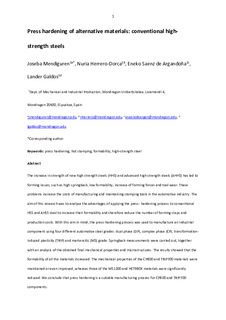Izenburua
Press hardening of alternative materials: conventional high- strength steelsArgitalpen data
2017Bertsioa
PostprintaDokumentu-mota
ArtikuluaArtikuluaHizkuntza
IngelesaEskubideak
© Springer-Verlag France SAS 2017Sarbidea
Sarbide irekiaArgitaratzailearen bertsioa
https://doi.org/10.1007/s12289-017-1379-yNon argitaratua
International Journal of Material Forming Vol. 11. Nº. 5. Pp 663–670. September, 2017Argitaratzailea
Springer NatureGako-hitzak
press hardeninghot stamping
formability
high-strength steel
Laburpena
he increase in strength of new high strength steels(HHS) and advanced high strength steels (AHHS) has led toforming issues, such as high springback, low formability, increase of forming forces and too ... [+]
he increase in strength of new high strength steels(HHS) and advanced high strength steels (AHHS) has led toforming issues, such as high springback, low formability, increase of forming forces and tool wear. These problems increase thecosts of manufacturing and maintainingstamping tools in the automotive industry. The aim of this research was to analyse the advantages of applyingthe press-hardening process toconventional HSS and AHSS steel to increase their formability and therefore reduce thenumber of forming steps and productioncosts. With this aimin mind, the press-hardening process was used to manufacturean industrialcomponent using four different automotive steelgrades: dual phase (DP),complex phase (CP), transformation-induced plasticity (TRIP) and martensitic (MS) grade.Springback measurements werecarried out, together with ananalysis of the obtained final mechanical properties and microstructures. The results showed that the formability of all thematerials increased. The mechanical properties of theCP800and TRIP700 materials were maintained or even improved, whereas those of the MS1200 and HCT980Xmaterials were significantly reduced. Weconclude thatpress hardening is a suitable manufacturing processforCP800 and TRIP700components. [-]





















